#Mark Gatiss Appreciation Society
Explore tagged Tumblr posts
Text
Okay so, tis the season of "Jonathan is a gothic heroine and also very feminized in Dracula's castle" and I would agree with these sentiments wholeheartedly, but when I look at how he is treated in adaptations (good and bad) and even in some well-meaning fics there's this sort of sexist undercurrent to feminizing him that ignores and undervalues the real skills he is employing to keep himself alive and it always bugs me. Alan Moore calls him a milksop (? Or was that Coppola) and Mark Gatiss calls him a wet noodle and it's just. He is a damsel in distress and he's very skilled and resourceful and active and trying to help himself. When he has his panic attack, and then sits down and thinks what he has to do, and decides that he should try to find out more about the Count and spends dinner that evening tactfully asking questions that keep the Count talking- like that's huge! That's a hugely important thing to do and it shows his interpersonal skills very well and that is not to be undervalued. Like if all you're going to do with a fem!Jonathan is keep him in Mina's purse you've really missed the mark, and you're ignoring his skillset. Only someone who is good at regulating their emotions, good at reading people, good at intuiting desired behavior, good at pretending could survive this. An assertive, direct approach to this situation would get Jonathan killed super fast. His "feminine" qualities are keeping him alive, and I want to see this aspect appreciated more than I do.
Also... I get why "feminine" and "masculine" qualities are called that, and I super agree that society deems things like emotional intelligence girly and so that needs to be discussed- but as someone who loves to read and write Mina in a masculine role and Jonathan in a feminine role... that's not exactly how I think about it tbh. Like to me the point is: emotional intelligence is obviously both masculine and feminine because Jonathan is emotionally intelligent and a man, not "Jonathan is a femboy." Like "feminine" qualities and "masculine" qualities have a societal meaning but in practice they're bullshit because both genders are capable of all qualities you know? And in my opinion that's what stories that play with gender roles should be saying.
491 notes
·
View notes
Text

Tomorrow the Mark Gatiss Appreciation Society will be gathering for a watch along! 2 PM US Central time, 8 PM UK time. (Mark is eager to join us, you can see.)
It's Time Bandits with the Earl of Sandwich!

15 notes
·
View notes
Photo

Announcing... the Mark Gatiss Appreciation Society!
I had so much fun watching The Quatermass Experiment with y’all that I wanted to make it a recurring thing. So I thought ... the Mark Gatiss Film Appreciation Society.
But I’d also like to watch Clone because he’s hilarious in that. So then it was the Mark Gatiss Filmed Entertainment Appreciation Society.
But then I remembered... he writes books! And a new one’s coming out (a Doctor Who novelization of one of his TV episodes). So I finally decided it should just be the Mark Gatiss Appreciation Society.
And because I love Tumblr, but it’s not very good for conversation and discussion and back-and-forth chat and polls... there’s a Discord! It’s just gotten started, but I’d love anyone who wants to talk about the wonder of Mark Gatiss or share photos or generally be a fan to join us. Please message for invite. All are welcome. Come figure out what we should watch next!
78 notes
·
View notes
Link
10 notes
·
View notes
Text
Doctor Who Appreciation Society launches The Terrance Dicks Award For Writers
Doctor Who Appreciation Society launches The Terrance Dicks Award For Writers
The Doctor Who Appreciation Society has announced The Terrance Dicks Award For Writers, in memory of the much-loved, and highly influential, writer who passed away in 2019. The Terrance Dicks Award For Writers, designed by Gary Glover of Mooncrest Models The award will recognise those whose writing across screen, audio, book and magazine have contributed to, and enhanced, the worlds of Doctor…

View On WordPress
#Doctor Who#Doctor Who Appreciation Society#Mark Gatiss#Terrance Dicks#The Terrance Dicks Award For Writers
1 note
·
View note
Text
T6T is a message for TJLCers
I was rewatching The Six Tatchers and noticed that, from the very beginning, there were subtle messages directed to us via Sherlock.
In this meta I’ll try to show you the most noticeable examples of that, so welcome to my first analysis of Sherlock.
1. One of the first lines we have in the episode, “that’s not what happened at all’’.
We are Sherlock and Mycroft and his super secret gang are Mofftiss.
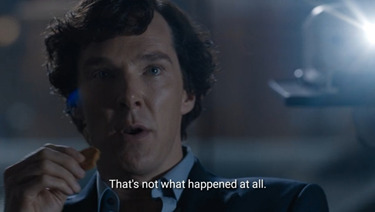
This may be one of the most blatant evidence, as a lot of us have already pointed out in emp theory or john’s tab theory.
Here, Mofftiss the “British Government” is showing us Sherlock fake footage. Sherlock, or rather us, immediately knows that all of that isn’t real, it’s made up. It’s a distorted version of reality.
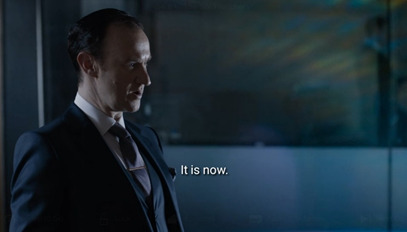
Despite us Sherlock knowing and saying it’s fake, Mofftiss Mycroft carries on with the lie, telling us that now, it is the only truth.
2. Mofftiss’ plans
We are Sherlock and Moriarty is Mofftiss (how ironic, huh)
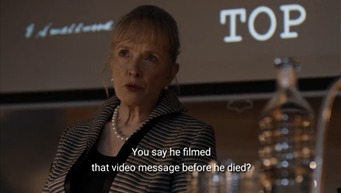
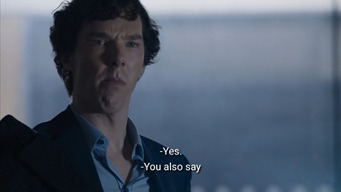
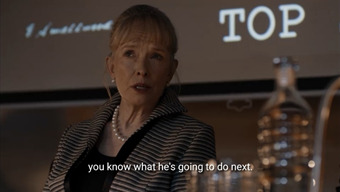
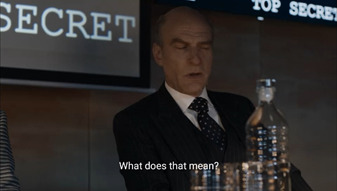
Moriarty Mofftiss filmed the message the series/lost especial before (t)he(y) “died”, dying as of disappearing. Now they are ghosts, lurking in the dark and making our pain prologue more and more, waiting for the perfect moment to announce the fifth season.
Lady Smallwood: You also say you know what he’s going to do next. What does that mean?
We know what Mofftiss are going to do, we know tjlc is the endgame of the series, even though Moffat and Gatiss themselves refuse to explicitly tell us.
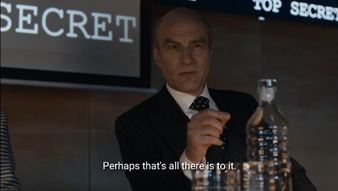
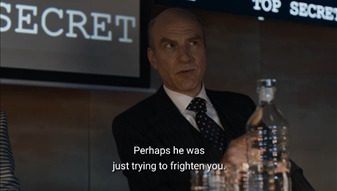
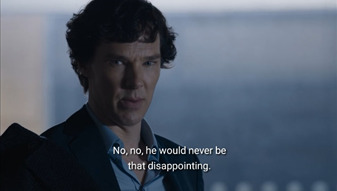
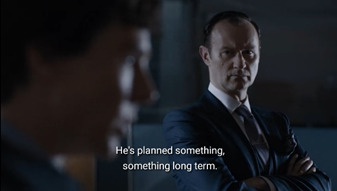
Sr. Edwin: Perhaps that’s all there is to it. Perhaps he was just trying to frighten you.
Sherlock: No, no, he would never be that disappointing. He’s planned something, something long term.
They are trying to convince us that that’s all there is to it, that s4 is all we have, and we’ll just have to take it on the chin. But we know that they would never do that, they aren’t that disappointing, they are Mark Gatiss and Steven Moffat for God’s sakes! They’d never do that to us, they’d never queerbait.
They have planned something (johnlock) from the beginning of the series, since the gay pilot. And those plans are still on.
3. Our plans
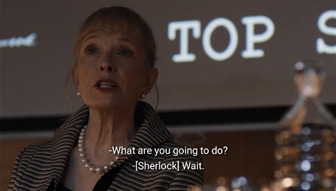
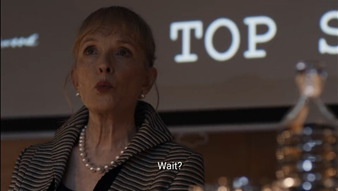
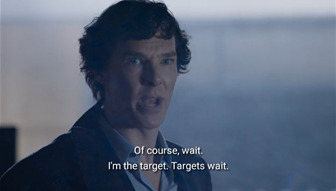
“What are we going to do in this long, exhausting hiatus?”
Well, what we’ve always done. We are the targets, targets wait, right? Mofftiss are the owners of Sherlock and we have to wait until they decide to start again.
But in the (painful) meanwhile, we’ll do what we are excellent at: we’ll rewatch the series again and again and go deep into the incredible layers of subtext.
4. Trick? Obviously
The trick is the released season four and the surprise is our predicted season four.
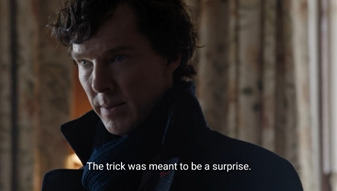
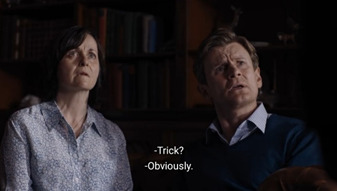
Sherlock: The trick was meant to be a surprise.
Mr. and Mrs. Welsborough: Trick?
Sherlock: Obviously.
The trick aired S4 was meant to be the foretold s4 a surprise (not to us, obviously, we knew what was going to happen, but rather to casuals and antis); but in the end, it didn’t take place.
The surprise expected season didn’t get executed, we didn’t have the explicit Johnlock we were hoping for. But we know that, unlike Charlie’s surprise, which didn’t happen; we will get our so deserved happy ending, with TJLC finally confirmed and Sherlock and John parenting Rosie as a happy couple.
5. Acronyms
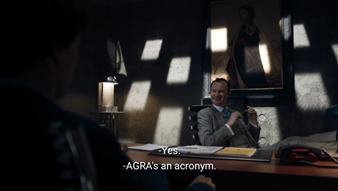
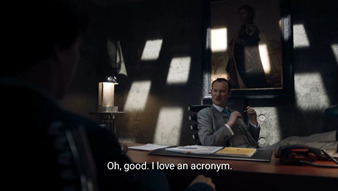
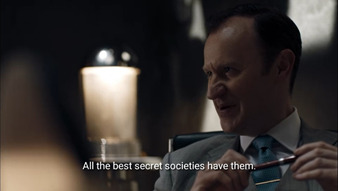
Sherlock: AGRA’s an acronym.
Mycroft: Oh, good. I love an acronym. All the best secret societies have them.
Well well, how do I start with this? It is clearly and blatantly about TJLC.
This scene works similar to the group of women in TAB and Chris Melas, Mofftiss are telling us they know about us, they know who we are, and they like us.
Mycroft (Mark) is not only saying he loves acronyms, but he also thinks that all the best societies have one! And even better, he is holding a pen!!
Ladies and gentlemen, this is evidently Mark Gatiss himself telling us he knows and appreciates TJLCers, this is him saying all of that directly to us, this time not even through Sherlock.
6. The butcher’s
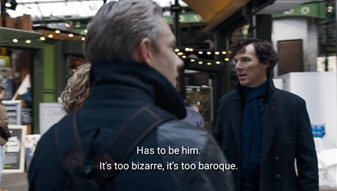
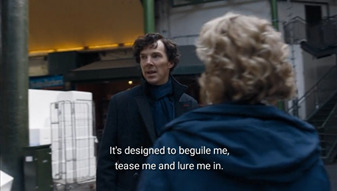
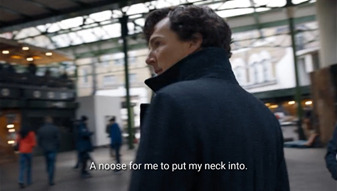
Sherlock is we are more than certain that it has to be a ploy made to confuse and mislead us.
Season four is too bizarre, too baroque, even Bond-esque and with countless plotholes. It has to be fake, IT IS FAKE. There is no other explanation to its fuckiness and nonsense.
It is also a rope to put our neck into, it’s a test we have to pass. And in a way, we like it, we have fun making theories and writing amazing metas; we enjoy it, that’s how we are. Just like Sherlock.
----------------------------------------------------------------------------------------
Well, here finishes my first meta (omg I thought I’d never be writintig that). This was all I could extract from the episode, I hope you’ve liked it!! If there is anything more you’ve noticed about T6T, please let me know. I’ll be more than glad to hear it.
I’ll leave some ‘must read’ links to emp and john’s tab theories:
John’s alibi masterposts by @/inevitably-johnlocked: link one / link two / link three
EMP huge masterpost by @/monikakrasnorada: here
EMP Tumblr blog @/emplock: here
#tjlc#my meta#the johnlock conspiracy#the six tatchers#t6t#tst#sherlock meta#sherlock#johnlock#bbc sherlock#sherlock bbc#tjlc is real#johnlock is real#my first meta#season four meta#sherlock season 4#season four is fake#emp theory#e/m/p theory#john's alibi#john's tab#unreliable narrator#sherlock holmes#john watson#mycroft holmes#johnlock forever#t6t meta#tst meta
222 notes
·
View notes
Text
Tagged (by proxy) by @shimyereh — and I extend the invitation to answer these questions if you see this and wish to take part. I’m a nosy bastard curious soul, so I’d love to see your answers…
Last book I bought: It hasn’t arrived yet, but I ordered the new Folio Society edition of The Haunting of Hill House, by Shirley Jackson.
Last book I borrowed: The Dig, by John Preston. I borrowed it from the local library, and I’m currently reading it. So far I’m digging it. Ahem.
Last book I was gifted: It was my birthday in February. Among the gifts I received were I Am Legend by Richard Matheson, and Never Let Me Go by Kazuo Ishiguro.
Last book I gave to someone: I have successfully pushed my bestie down the Terry Pratchett rabbit hole. I just sent her a birthday pakige, the contents of which will have to remain faintly mysterious for now — though she knows at least some of the titles in there.
Last book I started: The Dig, as I mentioned earlier. If you mean the last book I started and failed to finish, that was If on a winter’s night a traveller, by Italo Calvino.
Last book I finished: The Truth, by Terry Pratchett. And very —ing good it was too!
Last book I gave 5 stars to: According to Goodreads (which, it turns out, isn’t a social network for people with a phobia of slimy substances), The Fifth Elephant by Terry Pratchett.
Last book I gave 2 stars to: Dracula, by Bram Stoker. (Audiobook read by Mark Gatiss.) Did the audiobook fail to do it justice? Is bedtime not the best time for me to properly appreciate a book? Or is it just hard to take it seriously when all the twists are obvious to any modern reader with a passing knowledge of vampire lore? (The Count has no reflection! Hmm, what could that possibly mean? Any ideas, Jonathan? No? None at all? Seriously?) Who can say…
2 notes
·
View notes
Photo
There’s a thread on the Discord to decide! It would be an appropriate starting point, wouldn’t it? I hadn’t realized he was so adorable in it!
(Interested in joining us to talk about how much we enjoy watching Mark? Message for Discord invite!)



Mark Gatiss as Donald in “Locked Down”(2021)
60 notes
·
View notes
Text
Cyberons, sexy Zygons and Mark Gatiss: the bizarre world of the unofficial Doctor Who spin-offs
An oral history of the franchise's unlicensed spin-offs with Sylvester McCoy, Nick Briggs and those at the heart of Who's fan-made films

By Thomas Ling
Tuesday, 27th November 2018 at 1:19 pm
Colin Baker, the man who played The Sixth and arguably proudest Doctor, was next to naked. But he didn’t seem bothered by the bare front peeking through his limp dressing gown. And nor by the vision of a dying Peter Davison that had caused him to collapse while presenting a live TV weather report moments earlier.
Instead, in this semi-stripped moment, his focus belonged solely to Nicola Bryant, the actor who had played Doctor Who companion Peri – and the woman currently planting kisses down his exposed chest.
The 7 biggest contradictions in Doctor Who canon
RadioTimes.com newsletter: get the latest TV and entertainment news direct to your inbox
A surprising turn, many would think, but Baker seemed completely at ease. Yet soon there would be things he couldn’t ignore.
Soon he’d unearth a plot to replace humans with a synthetic race that could survive a poisoned atmosphere. Soon he would encounter a mysterious Michael Moore-style filmmaker who took the appearance of Sylvester McCoy. And, perhaps most worrying of all, soon he’d witness an apparition of Jon Pertwee that would vanish as unexplained as it had appeared.
Of all the directions Doctor Who could have taken, few could have predicted this. Yet the above is exactly how many fans celebrated the show’s 30th anniversary in 1993: watching a half-naked Colin Baker in The Airzone Solution, a fan-made straight-to-video multi-Doctor story.
Except this wasn’t actually a Doctor Who story. Not officially, anyway. But while Baker, Davidson, McCoy and Pertwee weren’t actually playing Time Lords, The Airzone Solution was Doctor Who in all but name. As McCoy explains to us, the film was “a kind of shadow of Who. Something different with major Whovian influences.”
And although not a licenced Doctor Who production, The Airzone Solution had more of a standing in the fandom than anything the BBC had gifted Whovians since putting the show on hiatus four years earlier in 1989.
While the amateur filmmakers behind Airzone managed to reunite four Doctors for an hour-long special, the BBC’s planned anniversary extravaganza The Dark Dimension collapsed completely mid-production. From its wreckage the Beeb merely marked three decades of the most influential British sci-fi creation with a Doctor Who/EastEnders crossover introduced by Noel Edmonds.
True, this Children in Need short saw the Tardis back on BBC1, but Romana riffing with the Mitchell brothers and the Fifth Doctor crossing paths with Pat Butcher was hardly the glorious return of the Time Lords many had imagined.
So, with fans’ appetites unsatisfied, thousands fed their hunger for Who with The Airzone Solution and the string of 24 other spin-offs films that emerged in the show’s wilderness years – the decade and a half without a regular Doctor Who TV series.
They weren’t official BBC stories, but they did heavily borrow from Doctor Who mythology and featured a mix of past actors, characters and suspiciously familiar monsters (no points for guessing what the ‘Cyberons’ were based on).
More importantly, though, these films nurtured Who’s biggest stars of the revived series. Writer and actor Mark Gatiss, voice of the Daleks Nicholas Briggs and writer Robert Shearman, alongside the likes of Alan Cumming and Reece Shearsmith: all cut their teeth on these films.
And while many of these stars might look back at them with a blush, the spin-offs may well be the reason they ended up working on the revival show.
Despite their shaky CGI, shoestring Sontarans and nymphomaniac Zygons (more on that below), these films actually silently shaped the Doctor Who we know today…
The first, the unoriginal, you might say
It all started in Wartime. All 25 spin-offs were sparked by this 35-minute one-off, a fan-made story that centred on Whovian favourite Sergeant Benton. Although not a household name for modern Who viewers, Benton was a stalwart soldier of the Pertwee era of the show, a key UNIT officer who battled against Cybermen, Daleks and even dinosaurs on Britain’s streets.
Yet it’s not the return of original actor John Levene as Benton, the character’s surreal confrontation with his soon-to-be-widowed mother or even the fantastically 1980s CGI skull that stands out about Wartime. It’s the release date: 1987, two years before Who was pulled off air.
In other words, Wartime wasn’t made in response to the cancellation, but for a very different reason.
“We made Wartime because we weren’t happy with the way that Doctor Who was going and we thought we could do better,” says Wartime producer Keith Barnfather, one of the founding members of the Doctor Who Appreciation Society and former BBC and Channel 4 employee.
“That was an absolute joke considering the funds available. The only reason that [Wartime] got made was that everyone who did it did it virtually for nothing.”
With borrowed costumes, a minuscule budget of only a few thousand pounds and a filming location they had never visited beforehand, Barnfather and his newly-formed production company ReelTime Pictures got Wartime in the can in just three days – about a fifth of the time it takes to film a modern Who episode.
The result: a creaky-looking drama with questionable effects and an enthusiastic but ultimately forced performance from Levene. But all these glaring flaws weren’t important. All that mattered was it had got made. A group of fans had actually put together a real self-contained show set in the world of Doctor Who.
“I was happy – it was the first time we did anything and we actually finished it!” says Barnfather. “It’s not a bad little drama. Even today I can watch it and not cringe.”
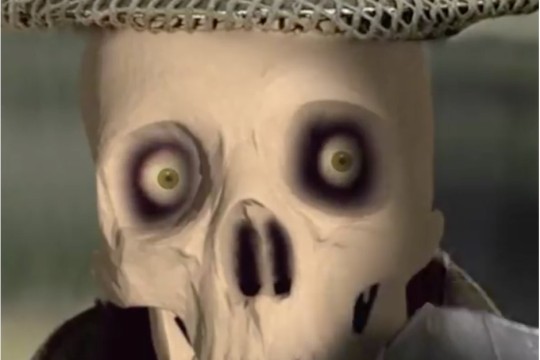
Most importantly, however, Wartime proved that independent spin-offs were possible. It showed that Doctor Who stories didn’t require Doctor Who on BBC1. Because when the show was finally cancelled two years later in 1989, other also looked to put their own Who adventures on camera.
And this time the Doctors themselves would want in…
The Time Lords materialise
Determined, brilliant, completely barking mad: there are many ways to describe Who filmmaker Bill Baggs. Indeed, some labelled him all three after he founded BBV Pictures in 1991, kick-starting projects with some truly out-of-this-world ambitions.
Why? Although only a young video editor at BBC Nottingham, the aspiring director/actor aimed to do more than tell Doctor Who stories about background UNIT soldiers. Baggs wanted the Doctors – and plenty of them.
Staggeringly, he got one in his first film. After a script was cobbled together for short drama Summoned by Shadows, Baggs approached Colin Baker to play a lead character known simply as The Stranger, a mysterious and eccentric unnamed traveller who roams time and space with a younger companion. Nothing like The Doctor, of course.
And despite not actually playing a Time Lord, or knowing virtually anything about the film, or having met the man behind it, Baker signed up.
“I could not believe it. I was wetting myself with excitement!” remembers Baggs. “As a Doctor Who fan you have little fantasies about this, but you never expect them to pan out! I was blown away and deeply honoured.”
Although we can’t be sure of Baker’s motives for coming on board – he declined to speak to us about the spin-offs – Baggs puts forward one theory: “I think from Colin’s point of view, he was doing a lot of theatre work after Doctor Who, so why not give up a few days and potentially invest in me, fool that he was,” he says with a laugh.
“From his point of view, I had no profile. He didn’t know me from Adam, apart from being this potentially up-and-coming director. But if you show passion and desire then often people will support you.”
Whatever the reason, Baker did join the project. And despite Baggs becoming cripplingly star-struck after meeting him at rehearsals (“I asked him for a cup of tea and disappeared down the corridor!”), filming soon started in true Doctor Who style: in an empty quarry – the same one, in fact, where Baker had filmed Attack of the Cybermen years earlier.
https://www.dailymotion.com/video/xanrcw
Like Wartime, this drama had a minuscule budget (just £3000 in total) and, as with the majority of Doctor Who’s 1980s episodes, it hasn’t aged well. Baker’s wonderfully understated performance, however, still shines through. He’s quiet and thoughtful throughout, showing fans exactly what his widely-criticised Doctor could have been.
As Mark Gatiss later told Doctor Who magazine (issue 332) about the films: “I remember watching them and thinking they didn’t look very flashy, but in terms of trying to portray real characters they were a massive improvement on Doctor Who!”
Gatiss wasn’t the only one taken with Summoned by Shadows and what would become ‘The Stranger series’ – thousands bought the films on VHS by post and at conventions.
Demand became too high, in fact. “I had to set up three VHS machines in my bedroom and I was duplicating videos through the night,” says Baggs, recalling how he had to call on his parents to help his videotaping “mini-factory”.
Above: a clip from The Stranger: More than a Messiah
So many copies would be sold, in fact, that by 1993 Baggs had the confidence to embark on a project bigger than anything he done before: a one-off special for Who’s 30th Birthday, The Airzone Solution, the film that would eventually feature a scantily-clad Colin Baker.
Fortunately, that scene doesn’t represent most of the film. Penned by the emerging Nicholas Briggs, Airzone was an environmental thriller set in a near-future Britain where pollution forces the government to build giant filtration plants to clean the dying planet.
And in true Doctor Who style, these centres actually serve a much more sinister agenda: kidnapping and experimenting on innocents to create a new species of human.
Baker once again signed onto the project and Baggs convinced Peter Davison to jump aboard (“that was another moment of punching the air!” Baggs recalls). This was soon followed by McCoy, a monumental achievement considering he was technically still Who’s incumbent Doctor.
Like previous spin-offs, this was by no means a major project with BBC1 exposure and a large pay-packet. But, for McCoy at least, it was a way of keeping the fandom thriving.
“We wanted to feed a hunger that was alive at that time for more Doctor Who,” he says. “I knew the BBC had made a huge mistake by putting Doctor Who into hiatus. I also knew the fans loved [the spin-offs]. For the fans I thought ‘yeah I’ll do this!’”
Bring back the Doctor Who pre-credits scene!
Former Doctor Who star Christopher Eccleston threatened to sue the BBC after quitting show
Furthermore, with a TV revival appearing absurdly unlikely in 1993, McCoy considered the project the only way Who could survive on screen.
“You might find this hard to believe, but I don’t really have a Tardis. I couldn’t really travel back in time and tell everyone ‘we’re going to make a TV film and then they’re going to bring it back again!’” he chuckles.
With these three star signings, others followed suit. Actors including Nicola Bryant, original Davros star Michael Wisher and the then-relatively-unknown Alan Cumming all joined the film.
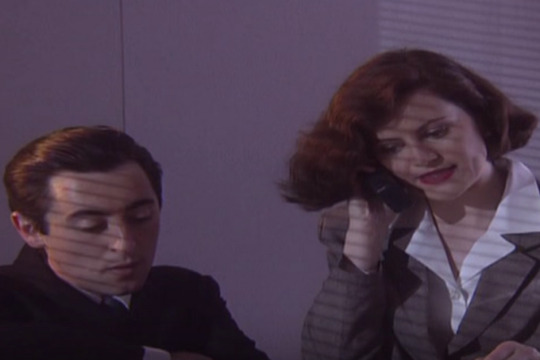
But then someone even the omni-ambitious Baggs thought too unattainable got in touch: Jon Pertwee, The Third Doctor. “Sylvester came to me one day and he said ‘I’ve been speaking to Jon Pertwee and he’s been asking why he’s not in it. He might get in touch!’” Baggs remembers.
Sure enough, the call came, with Baggs happily at the former Doctor’s mercy. “It was very charming to actually have an actor so connected to the show call and say ‘I’m in it, whether you like it or not!’”
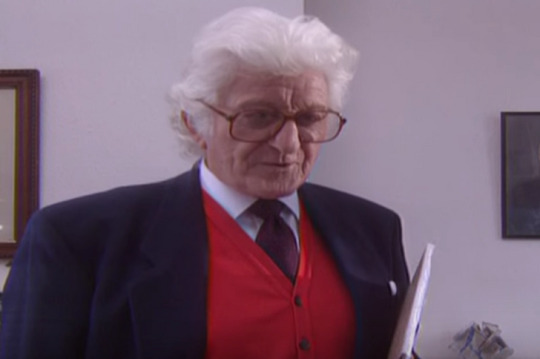
Pertwee may have been completely unfamiliar with the script when he turned up to set the next day – Peter Davidson actually had to hold up cue cards for him during scenes – but in it he was. And for two days, four Doctor Who leads were brought together for some good old-fashioned low-budget sci-fi.
“It obviously didn’t have quite the financial support that the BBC gave Doctor Who. But it was great because the fans were so involved,” recalls McCoy “We were treated very well. We all had a great time!”
McCoy’s recollections of the shoot are all positive, whether teasing Baker “for taking his job”, filming a chase scene that would fail any modern risk assessment (“I took my glasses off and would be driving around half blind!”), or simply spending time with his Doctor Who co-stars.
“I remember filming and just sharing the day with Colin, Peter and the glorious Jon Pertwee. It was great because it was still alive. When the BBC stopped it, you thought ‘well, that’s it, goodbye’. Doctor Who is one of the great jobs,” he says.
“And although this wasn’t Doctor Who, it was very like Doctor Who.”
The Pandorica opens
As suddenly as the Tardis surfacing from the time vortex, a whole series of Doctor Who spin-offs materialised after The Airzone Solution. Some good. Some bad. All brilliantly weird.
For ReelTime, the makers of Wartime, the next Who project entailed a team-up between Elisabeth Sladen’s Sarah Jane Smith and The Brigadier (a role reprised by original actor Nicholas Courtney) in a story called Downtime featuring the Great Intelligence and some gloriously low-budget Yeti monsters.
This was followed up by adventures featuring Sontarans, a Shakespeare-loving Draconian and even former Doctor Who companion Sophie Aldred, this time playing an unnamed character with, completely coincidently, the same direct way with words as Ace.
But while these characters were typically used with the BBC’s permission, other spin-offs – mostly those created by maverick Bill Baggs under BBV Pictures – simply gave a heavy nod to Who, such as the murderous robotic machines featured in Cyberon or the aforementioned interstellar traveller The Stranger.
But despite the glaring similarities, there seemed to be little fear of the BBC shutting down production. “We didn’t care!” laughs McCoy, who starred in many of Baggs’s later spin-offs. “They deserved to get annoyed because they abandoned it and the fans!”
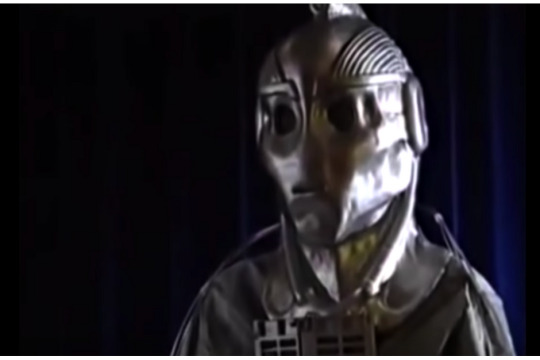
On other occasions the dramas blended the show’s characters and actors in ways that, simply put, just didn’t make a lot of sense – even by Doctor Who’s timey-wimey standards.
Take the Torchwood-esque PROBE series, directed by Baggs and penned by future Who and Sherlock stalwart Mark Gatiss, a writer slowly gaining success with The League of Gentlemen at the time.
This mid-1990s series centred on the Preternatural Research Bureau, a paranormal investigations unit led by classic Doctor Who companion Liz Shaw, a character Baggs had got permission to use. Original actor Caroline John even reprised the role, a casting that appeared to ground the drama firmly within the world of Who.
However, for rights reasons PROBE wasn’t permitted to mention The Doctor or most events surrounding the show – a restriction that meant Liz was forced not to recognise a non-Time Lord character played by John Pertwee, an actor she had shared adventures with during his tenure as The Doctor.
Mostly, however, the spin-offs followed new characters battling old Doctor Who baddies as they wreaked havoc over the planet. Most notable of which were the Auton films.
Featuring the likes of Reece Shearsmith and CGI that rivalled that seen in the 2005 revival show, the first two of BBV’s ‘Auton Trilogy’ of the late nineties are widely considered the best independent Who spin-offs.

“They are by no means perfect, in fact they’re horribly flawed. But I wrote and directed both of them under fairly impossible budgetary and time constraints, with a lovely team of actors,” says Nicholas Briggs. “I think we managed to create something that worked pretty well.”
However, Auton’s biggest impact on the Who fandom came just before the revival of the main show. Just as the BBC had to reach a deal with the Terry Nation estate to use the Daleks in the show (negotiations that fell through at one point overallegations the broadcaster wanted to make a ‘gay Dalek’ cartoon), they had to consult Bill Baggs, who still held the rights to the Autons thanks to an agreement with the estate of creator Robert Holmes.
“Before it restarted, the BBC phoned me up and asked me if was okay for me to do an Auton show,” laughs Baggs.
“I told this to my wife thinking she wouldn’t say anything, but it happened to be the weekend she was at the Gallifrey convention. And a bit later I got a phone call saying ‘why does the whole universe know that the first episode is an Auton one?!’ I had to apologise humbly.”
Furthermore, some have said characters created for these fan-made spin-offs may have actually inspired those that appear in the main show. Foremost of which: Kate Lethbridge-Stewart, UNIT commander and daughter of the Brigadier.
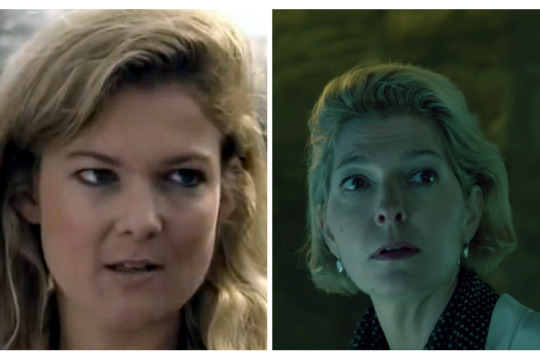
Kate appeared in Chris Chibnall’s The Power of Three in 2012 and the 50thanniversary special The Day of the Doctor – but a character with the same name, background and blonde hair first featured in fan-made film Downtime 17 years earlier.
“Let’s just say we came to an accommodation,” says Downtime producer Barnfather on his subsequent chats with the BBC around their use of the character. “I would never do anything that would hurt the programme or bring it into disrepute.”
Yet Kate Stewart aside, can we say these fan-made spin-offs really gave more to Doctor Who than they took? Did they really inspire the plots of modern Who? Considering the stories the show has produced since its 2005 revival: absolutely not.
However, what if you judge the impact of the spin-offs by the talent they gifted to the main show years later? Well, that’s when things get a lot more interesting…
Stars are born
However flawed these films were, they’re where the Who writers of today learned their craft. They didn’t just make talent like Mark Gatiss and Big Finish head Nick Briggs known amongst dedicated fans, they also gave them a platform to jump to the main show. And, even more importantly, they nurtured the creativity needed for their later projects.
Briggs is the prime example here. Through his extensive work in the world of unlicensed Who he perfected performing Dalek voices, mastering the equipment and vocal tics needed to make a convincing tinpot terror. And this meant when the BBC announced the Doctor Who revival, Russell T Davies was quick to get Briggs on board.
“[Davies] had me in mind from the moment he’d decided he was bringing the Daleks back – not just because he thought I was good at doing Dalek voices, but because he was aware that I had the technical know-how to recreate them,” Briggs explains. “In the absence of a BBC Radiophonic Workshop, I was the sort of total solution. Very lucky for me.”
However, the spin-offs did much more than offer Briggs a route onto the main show. “Any ‘turn around the block’ creating something, no matter how flawed, is invaluable experience for a writer or director or any kind of creative person,” he says.
“It’s one thing to dream, but it’s quite another thing to get the practical experience of actually creating and finishing something.
“[The spin-offs] gave us a real ‘go’ at bringing a dream to life, and helped us realise that we could not only create something, but create something worthy of an audience.
“Actually making things engenders a feeling of permission to create. That’s a big hurdle for any creative person. Do I have the right to create, to communicate, to entertain? Having practice at making something helps to give you that feeling of permission.”
Mark Gatiss echoed a similar sentiment in a League of Gentlemen blog, explaining that although he didn’t want it to be released on DVD, he had gained valuable experience writing The Zero Imperative, his first ever TV script.
“Christ, for all I knew, they were the only things I would ever get to make,” he said. “And I learned a frightening amount from working on them.”
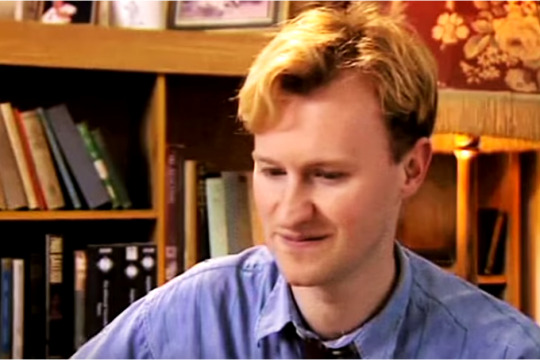
And one of the lessons Gatiss appears to have learned is how to work with some tricky characters. Namely, Bill Baggs.
“I’m a constant meddler when it comes to the scripts,” recalls Baggs. “But Mark tolerated that really well. I remember we would sit together and improvise scenes, which I loved. I’d like to get hold of his writing sometimes and give it a tweak and an edit, but I take my hat off to him. He’s been so successful. There’s nobody else who deserves more and having that experience with him is fantastic.
“But Mark probably wouldn’t have his career in Doctor Who without BBV.”
So, why didn’t Baggs end up working on Doctor Who like Gatiss? Why is it that the man at the heart of the unofficial fandom spent, as he puts it, “a lot of time wondering when the phone was going to ring”?
Rather than being asked to direct an episode, why did Baggs fail to break through to the show, instead funnelling his energy into an alternative medicine, Emotional Energy Healing, and becoming an ‘Akki energetics practitioner’?
Despite Baggs’s assertion that he could work on the main show if he wanted to but simply chooses not to, there could be another reason behind his absence. As Gatiss once told Doctor Who magazine, although he had a “great time”, Baggs “had some very strange ideas as a producer.”
And although Gatiss was referring to Baggs’s tendency to swap scenes around “arbitrarily”, this isn’t one of the strange ideas that fans eventually knew him for.
The misadventures of Doctor Screw
We should say this up front: Bill Baggs wasn’t the first to bring sex into the Whoniverse. During the show’s hiatus years, characters such as Bernice Summerfield (written as a companion of Sylvester McCoy’s Seventh Doctor) were often portrayed enjoying some, shall we say, advanced docking maneuverers on the Tardis. Summerfield even apparently had a fumble with The Eighth Doctor himself in book The Dying Days.
However, while ReelTime Pictures kept their films PG and in a similar style and ilk to the main show, stablemate BBV and Bill Baggs became ever more proactive in bringing the saucier side of Who to screen.
That image of a naked Colin Baker we brought up before? The one where he romped with Nicola Bryant, who played Peri in Who? That was thanks to Baggs, who directed the unscripted scene (from under the bed – “I had to! There was no space in that room!”) against the wishes of writer Nicholas Briggs.
“I’m credited as the writer of The Airzone Solution, but I did not write that scene,” Briggs says adamantly. “It was irrelevant to the plot. [Baggs] seemed to agree with me. But I later found out that he just gave up arguing because he could see I wouldn’t change my mind. Then he deliberately deceived me and wrote the scene in any way.”
Baggs, however, stands by it. “Everyone had an opinion about it,” he says. “People got grossed out by it and some found no problem at all.”
But that scene was nothing compared to 2008’s Zygon: When Being You Just Isn’t Enough, dubbed by one reviewer as “the only Zygon-based soft-porn film ever to have been made”. And that’s not an exaggeration. Fortunately, it doesn’t feature the red starfish-like aliens making use of their suckers, but the 18-rated film does see the Zygons at the centre of some very NSFW activities in human form.

Although billed as a serious drama, Baggs openly says it was initially envisioned as something more titillating. “I met a guy at a convention who was into soft porn and he convinced me there was a market for it – not that I had a massive desire to produce a soft porn film, but you’re always interested as a director/producer what markets there were.”
But looking back now, Baggs concedes the project was a misstep. “It was my mistake and nobody else’s,” he adds, before quickly adding: “I’m glad I tried it, though. It was a massive learning experience.”
Zygon wasn’t quite the end of Baggs’s spin-off ideas, with BBV releasing When to Die, a PROBE drama in memory of Liz Shaw star Caroline John in 2012.
However, since then Baggs has been focused on producing theatre dramas, and although he and McCoy still enjoy times together at conventions, the sun has set on the golden time (and space) of BBV films.
A fandom regenerates
26th March 2005, 7pm. For fans across the world, this was the moment the ‘real’ Doctor Who returned to screens. After over 15 years of waiting, the universe’s foremost Time Lord returned in a regular series, captivating a whole new generation of Whovians.
But for the makers of the spin-off films, it was a bittersweet moment. Producers like Bill Baggs had spent years trying to cater for fans with nowhere else to go, fuelling the fandom with films made possible by pure passion for Who. And now it was over: the fans just didn’t need BBV.
As Baggs says, “It was frustrating on one hand and utterly delighting on the other.
“Before they announced they were reviving Who, Alan Cumming and I were actually going to do a special drama, an anniversary special for BBC South with Alan Cumming as The Doctor,” he laments. “But we ended up getting a call from a Who producer telling us we had to stop because the show was coming back – that’s when I first found out.”
Today BBV only operates a small web business and while Barnfather and ReelTime Pictures still film an occasional Who spin-off, they mostly specialise in the likes of archaeological videos in the Greek world (“We’ve got quite the reputation in Cyprus”).
Yet some still claim that fans owe a great debt to Barnfather and Baggs. “Thereason why we’ve got Doctor Who now on television is thanks to those fans who did it way back then,” says McCoy. “The fans of today should be thankful to him because he helped keep alive Doctor Who.”
But is it really true that without their work keeping the fandom alive, the BBC would have never recommissioned the show? Not everyone is convinced.
“That’s absolutely rubbish,” says Barnfather. “The programme would have come back – it’s a franchise that will never die! Even if the Doctor Who fandom didn’t exist, the BBC would have brought it back.”
“The facts just don’t support it,” agrees Briggs. “The people who made the decision to bring back Doctor Who to television had no idea that any of these things existed.”
Yet while it may not be the reason for Doctor Who’s revival, it’s undeniable that these films fostered talent that would change the Tardis forever.
Perhaps more than anything, the films represent how the fandom and the series are forever intertwined. These 25 forgotten spin-offs demonstrate that the line between dedicated fans and the show is beautifully permeable, ideas and talent forever travelling between the two.
And that’s still true to this day. Remember WhoLock, the viral video that imagined two of TV’s greatest characters together? Or the perfect fan-made trailer for Peter Capaldi’s first series? The editor of these films, who goes by the pseudonym John Smith, actually went on to work as a VFX artist for Doctor Who.
This is the real beauty of Who: its fans are constantly creating, inventing new ideas that could make their way on screen in years to come. It’s a collaboration that makes Who and its lead Time Lord arguably stronger than any other sci-fi fandom.
And sure, this symbiotic relationship might bring to light some of the stranger facets of the fandom, or a nymphomaniac Zygon or two. But, just like the Tardis, these spin-offs have often taken The Doctor where he didn’t want to go, but precisely where he needed to.
Sign up for the free RadioTimes.com newsletter
Tags
Sci-fi
Alan Cumming
Mark Gatiss
Reece Shearsmith
Doctor Who
Related news
Doctor Who Sleep No More review: Mark Gatiss keeps us wide awake in his spookiest episode yet
Alan Cumming was asked to play the Doctor – but there was one crucial requirement that put him off
All about Doctor Who
News, photos, videos and full episode guide
[x]
#MG#mark gatiss#doctor who#Radio Times#alan cumming#the man behind the genius#interview#all things MG#all about doctor who
9 notes
·
View notes
Text

The Mark Gatiss Appreciation Society is having a short meeting tomorrow at 2 PM Central US / 8 PM UK time.
7 notes
·
View notes
Link
Tushar Lall’s remarkable journey of bringing about a change in how people listen to classical music and make it more appealing for teenagers is indeed a motivational story and he is a motivation for teenagers like us who are the future of society. Through music, he has been able to cure someone’s daughter as confessed by the girl’s mother. So what’s all the waiting for? Let me take you through his beautiful and remarkable journey and appreciate the work he’s doing.
Founder’s Background
Before the beginning of making his journey a remarkable one, Tushar Lall was a student of Jai Hind’s College in Mumbai where he pursued a diploma in music production. He then left for DubSpot in New York at the age of 17 to pursue a course on sound design, mixing and mastering. In the initial stages, Tushar revealed that his parents did not know how to react to their son’s decision, and supporting them he also said that they are not to be blamed at all.
He said that he understood the fact that they came from a different background. He came from a family of bureaucrats where he had no connection with music but his great grandfather was a multi-instrumentalist. Tushar was not formally trained but he made his way to the piano when he was only 4 years old.
The Indian Jam Project – The Beginning
The thought of creating such remarkable fusion music came to him while he was pursuing his diploma course and spending time around classical musicians at the college. After he returned to Mumbai, the first video of him and his friends was the cover of Game of Thrones which he had put uploaded on his YouTube channel. They did not have a name back then. The name The Indian Jam Project came up when the composer of BBC’s Sherlock theme, Michael Price shared their cover video as Indian Jam on Sherlock. Though he felt that the name wasn’t the best and he could have come up with something better, he accepted it as a name that sorts things out.
The Indian Jam Project – Introduction
Tushar Lall shoulders the responsibilities of being a founder, producer, and composer of the Indian Jam Project. He has made several Indian adaptations of western songs of Coldplay, Game of Thrones, Titanic, Mission Impossible, and several others. Not just that, this band has also joined hands with Imagine Dragons to create an Indian classical version of Believers which crossed more than 7.5 million views.
Tushar said that when he started looking around, Gautam Buddha was the first thing that crossed his mind. He renounced a lot of things to seek spiritualism. His first step was made with Sifar, not a song but an orchestral piece. The idea of Sifar came to him in 2016 when he was a part of the YouTube FanFest and got singers Tajinder Singh, Shatadru Kabir, and Mame Khan to give life to the piece of melody. He kept the best for the last as it was his final decision to include the Budapest Art Orchestra and make his original grand and also stay true to its ideology.
Suggested For You How Aparna Rajwat is empowering women by training them to become mentally and physically stronger through Pink Belt Mission
The success story – Our motivation
The music of the Indian Jam Project has been appreciated by Michael price, Mark Gatiss, Clint Mansell among others. Tushar and his team have traveled to various places for concerts and performed at events like TedX, YouTube FanFest, IITs, IIMs, Private Gigs, and corporate events. One of the several reasons why he’s a motivation for us is that he’s one of the youngest YouTubers who has been awarded the Dadasaheb Phalke Award in Digital Space in 2019.
To know more about Tushar Lall, please check – YouTube, LinkedIn, Instagram, Facebook, and Twitter.
If you know more inspirational stories about a person, company, new idea, or social initiative, and want us to write it on mad4india.com, share such information with us on Facebook and LinkedIn.
0 notes
Text
The Crimson Horror - Doctor Who blog
(SPOILER WARNING: The following is an in-depth critical analysis. If you haven’t seen this episode yet, you may want to before reading this review)

I really want to love The Crimson Horror. After my constant berating of his Who stories, it’s nice that Mark Gatiss has finally gone back to doing what he does best. Camp and macabre horror.
There are a lot of things to like. At first things start off really intriguing. Set in Yorkshire 1893, red corpses start showing up in the river and this so called ‘Crimson Horror’ appears to be connected to the recently opened Sweetville. A utopian community run by Mrs Gillyflower, played by Diana Rigg, and her silent partner Mr. Sweet. It’s a really great mystery that feels very reminiscent of other Victorian era Who stories, most notably The Talons Of Weng-Chiang, and a lot of the characters and plot points feel like stuff you’d find in Gatiss’ The League Of Gentlemen. This isn’t the first time Gatiss has done the Victorian era of course. His first ever Doctor Who was The Unquiet Dead during the Christopher Eccleston era, but while The Unquiet Dead felt like it was being held back due to the Doctor Who setting, The Crimson Horror seems to dive headfirst into this twisted world Gatiss has constructed. It’s still kid friendly, but there’s something really quite yucky about this episode. The corpses in the river alone should give kids nightmares, but then we also have to contend with very dark themes like eugenics, Victorian values and views of what is considered decent and moral, and domestic abuse.
The standout stars for me are Mrs Gillyflower and her daughter Ada, played by Diana Riggs’ real life daughter Rachel Stirling. Both are incredibly well written and well performed, and both are used to great effect. Mrs Gillyflower is incredibly sinister and really highlights the strict religious values of the time period. She believes that society is in decay, using her own daughter’s blindness to demonstrate this, and offers her followers salvation in Sweetville. Sold as a utopia for people to live and work, it’s actually just a front to preserve her victims for her ‘New Eden.’ (The giant gramophones playing sounds of factory noise to fool the applicants was a nice touch). It does in some ways cover the same ground as The Rings Of Akhaten in terms of its criticism of religion, but this is goes slightly further in a different direction. She’s obsessed with perfection, only accepting the best to be preserved in her glass jars (which is creepy in and of itself) and discarding the rejects into the river with the rest of what she perceives as muck. Her views are beyond horrific and her actions are truly deplorable. The scene where she coldly rejects her daughter, calling her unfit for her vision, was very uncomfortable to sit through. She ruined her own daughter’s life for her own utopian vision and then just left her on the scrapheap.
Ada is a very sympathetic character, caring for the Doctor while he’s been Crimson Horrored. However I do appreciate how they don’t take her down the innocent and naive route that you normally see with these kind of abuse stories. She may be blind and a victim of a mother’s cruelty, but she’s not in any way weak. In fact there’s more than a little bit of her mother in her. When she discovers the truth about her blindness, how it’s the result of her mother’s experiments rather than an abusive father, her fit of rage feels very similar to Gillyflower’s behaviour. And let’s not forget that while she did save the Doctor and looked after him, she also chained him up and locked him in a cell. She effectively imprisoned him for being a ‘monster’ just like how her mother imprisoned her. Of course Ada’s motives are slightly different. She’s driven more by a sense of loneliness rather than any selfish goals, and it doesn’t make her any less sympathetic. I’m glad she ended up getting a happy ending and now that she’s free of her mother’s poisonous influence, she’s free to live a life of her own and actually make friends and companions, which she couldn’t do before.
It’s these two characters and the execution of the whole mystery plot that allows me to look past some of the episode’s shortcomings. The reveal of Mr. Sweet (a Silurian parasite) clinging onto Mrs Gillyflower’s bosom was both icky and funny in equal measure, but I didn’t fully understand what the purpose of it was. Was it just providing the venom? Was it somehow influencing Gillyflower’s behaviour? What was its motivation if that was the case? And I don’t understand how a Victorian era chemist was able to build a rocket in her basement, nor how she intends to poison the entire world using one titchy bottle of venom. But as I say, the execution is so good and the characters of Gillyflower and Ada are so intriguing and engrossing that I honestly don’t mind.
Like I said at the beginning, I so desperately want to love The Crimson Horror. There’s so much good stuff in here. Unfortunately it’s all let down by the usual suspects.
Why couldn’t the Doctor have stayed Crimson Horrored throughout? Have the Paternoster Gang be the sole protagonists who just happen to discover the Doctor while they’re investigating and have to find a cure for him whilst they handle Gillyflower. Actually take the opportunity to develop the characters properly at last and give them a story outside of the Doctor. Alas, they’re still just as dull and lifeless as before. As I’ve said in the past, I’ll never understand why people like the Paternoster Gang because they don’t actually have interesting characters. Madame Vastra is boring as fuck, Jenny very quickly slips into the Moffat default of sassy dominatrix (which in Victorian times would have been scandalous), and Strax... Look I never found him funny to begin with, but even if he was amusing the first time around, he most certainly isn’t amusing now because it’s literally the same joke over and over again. Strax wants to blow something up, Vastra or the Doctor says no, Strax leaves in a huff. It’s just boring now.
In fact a lot of the humour doesn’t work in this episode. We have that journalist guy who keeps fainting every five minutes. That got old very fast. The Strax jokes, as I said, aren’t funny anymore because we’ve heard them a thousand times now. But the worst joke of all has to be when that random kid shows up to give Strax directions to Sweetville:
Strax: “What is your name?”
Kid: “Thomas sir. Thomas Thomas.”
OW! OOOOOOOOWWWWWWW! OH GOD! SOMEONE PHONE AN AMBULANCE! I THINK MY CRINGING PIPES HAVE BURST!
And the worst offenders are of course the Doctor and Clara. I’m really getting sick of their constant pissing around. It’s not in the slightest bit funny and actually distracts from some of the far darker and more emotional moments. Particularly the scenes with Ada. The scene where she kills Mr. Sweet, the source of all her torment and misery, should have been really powerful, but then it’s all ruined by Matt Smith undercutting it with humour. (Also the Doctor sexually assaults Jenny and there’s an erection gag involving the sonic screwdriver. I really wish they didn’t do that). And do we have to keep going on and on about how Clara is impossible? Unless you’re going to give us an explanation for why she’s impossible, shut the fuck up and get on with the story.
It’s frustrating because if this story featured any other Doctor and companions, I honestly wouldn’t hesitate in calling The Crimson Horror a classic. It’s easily one of the best things Gatiss has ever written for the show (it meant putting up with 8 years worth of crap from him, but we got there in the end) and it really plays to his strengths as a writer. If only we had a Doctor and a companion who was even vaguely tolerable (only 4 or 5 more episodes to go until he regenerates. Just hang on Quill. Grit your teeth and you’ll get through it).
#the crimson horror#mark gatiss#doctor who#eleventh doctor#matt smith#clara oswald#jenna coleman#steven moffat#bbc#review#spoilers
16 notes
·
View notes
Photo

I'm so pissed off with Instagram for removing my Val Denton post - again! I can't be asked to post it again because I know it's just going to get taken off or reported or whatever... If you want to see it, look on @silentshearsmith's account. Behind The Scenes of The League of Gentlemen. (Found on Facebook & Instagram. Credit: @) #TheLeagueOfGentlemen #TLOG #BehindTheScenes #BTS #TV #TVSet #Set #Television #Filming #MarkGatiss #ReeceShearsmith #StevePemberton #JeremyDyson #Hadfield #RoystonVasey #Local #BenjaminDenton #ValDenton #TheDentons {If you like The League of Gentlemen or Mark Gatiss (as a general), as well as the Sherlock Groups, you can also join these groups on Facebook too: -Bring Back "The League of Gentlemen" -League of Gentlemen Appreciation Society LOGAS -League of Psychos Inside No 9 -League of Fans Inside #9 & Psychoville -Gatiss Girls/Guys, Hallard Hooligans & Bunsen Bunnies} (at Royston Vasey)
#thedentons#reeceshearsmith#local#markgatiss#tvset#jeremydyson#theleagueofgentlemen#benjamindenton#bts#behindthescenes#tv#roystonvasey#set#filming#9#tlog#stevepemberton#hadfield#television#valdenton
3 notes
·
View notes
Text
This is why we have the Mark Gatiss Appreciation Society @markgatissappreciationsociety because you’re not the only one.



This happens to me when I look at Mark/Mycroft 😍😍😍🥰🥰🥰💖💖💖💞💞💞
68 notes
·
View notes
Text
Yuri!!! On Ice: The Power of Delivering to Your Audience

Introduction:
Ask yourself: what do you you want to get out of your entertainment? If someone were to ask you to make a detailed outline of everything you want to see in any television show, movie, game, book, album, or other form of media, what would be on your list? Not what type of genres, settings, characters or stories you would prefer, but what themes, qualities and values would you look for? When you go into a movie theater, pick up a book, put a disc into a console or reach for the remote, what is it you hope to come away with?
One thing I’ve noticed from personal experience and from spending time with other fans is that sometimes recognizing everything we want in entertainment is difficult to do. We might prioritize things like good writing, representation, a unique concept or a story that wraps up all it’s threads, but all of those things can be present in a piece of entertainment and still leave us underwhelmed. In cases like this we often discover that we have more expectations for entertainment than we originally thought. While we receive everything we thought we wanted, we walk away disappointed because it wasn’t everything we internally craved.
There are some critics who have large, specific lists of things they look for in media, but generally, that’s not the case for most casual fans of entertainment and storytelling. Our mental list of things we want out of a story is constantly changing as we grow and develop as people and as society changes around us. If we knew what we wanted to see all of the time, we’d never get excited or surprised or disappointed by anything. We’d never have that inexpressible feeling that leaves us with nothing else to say except for, “I don’t know what I just witnessed, but I loved it.” We may not be able to point out everything that needs to be included in a story for us to feel satisfied, but when we receive something that speaks to and connects with us in a surprising and personal way, we realize that it’s exactly what we’ve wanted all along.
It turns out it’s just as difficult for creators to understand what their audience wants to see as it is for fans. While a lot of entertainment is about creating art for the sake of art and telling our stories through media, it’s also an industry in which creators hope to appeal to general audiences to make a profit, which is a lot harder than it might seem. We see tropes and trends in entertainment that people are generally dissatisfied with and bored of, but we don’t see them disappearing. At least not quickly, because its just as difficult for creators to recognize the growing trends and wishes of their audience as it is for the audience to recognize their ever changing expectations.
Hayao Miyazaki, the critically acclaimed anime director and founder of Studio Ghilbi, recently made some bold complaints about Japan’s current anime industry. “Some people spend their lives interested only in themselves. Almost all Japanese animation is produced with hardly any basis taken from observing real people...it’s produced by humans who can’t stand looking at other humans.” (Source) While Miyazaki takes a very cynical approach, I think he may be onto something concerning how many creators, not just in anime, but in all entertainment mediums, don’t seem to know how to connect with their audience.
Delivering To Your Fans:
However, every once in a while, a group of creators come along that seem to grasp the answer to this mystery. Sometimes it’s in the form of paying tribute to fans. When BBC’s Sherlock Season Three began airing, written by Steven Moffat and Mark Gatiss, fans immediately took note of the show’s unique structure. Even now jokes are still made about how it’s essentially “like watching fanfiction”. In a lot of ways, Sherlock Season Three feels like a big thank you fans and a sign that the creative team was keeping an eye on what their fans wanted and appreciated their support.
In Spring 2016, anime studio Trigger, famous for their ridiculous, over the top stories, characters and settings, started airing two new shows. One, called Kiznaiver, was structurally different from anything the studio had ever done before and what fans had come to expect from them. This experimental project received mixed reviews. The other was Space Patrol Luluco, which felt less like an actual story and more of a tribute to their fans. In this show, Trigger returned to the wacky, senseless style of storytelling people loved them for while heavily referencing all of their previous works, making the whole thing feel like a giant thank you to their fans for putting up with their weird experiments and a promise to deliver what they wanted to see in the future. These, of course, are examples of creators who observed their fan base and gave them what they wanted to see. However, there are some pieces of art and entertainment that appeal to the general public on a fundamental level, whether the viewer is a fan of the genre and medium or not.
Delivering to the World:
One such show from the Fall 2016 season surprised everyone with how quickly it took root within the internet fan community, given how little it was hyped up beforehand. Yuri!!! on Ice, an original sports anime, began its run and managed to capture the hearts of anime fans and non-fans alike. This show swept the internet by storm, rapidly gaining popularity with every new episode. Viewers started noticing how the show was constantly one step ahead of what they wanted and expected to see.
What gives Yuri!!! on Ice this power to connect with such a large group of people is the humanity of its characters, both in conception and action. While they all reach for the same goal, to win a gold medal in the world ice skating competition, we’re given in depth looks into their lives and who they are as people. Both Yuri and Viktor are set up to be complex and interesting characters far before the show goes the final step to establish their canonical gay relationship. When that happens, it still doesn’t become the point of the show’s focus, nor is it fetishized or aimed towards the fujioshi community in any way. It’s presented as just one of many parts of their lives as they work together to accomplish their goals. Their love and passion for their dreams and for each other is something that all audiences can easily connect with. What’s really interesting about how this show presents Yuri and Viktor’s relationship is that all the supporting characters accept the fact that they’re in a relationship without question. There aren’t any jokes or gags revolving around their sexuality like we’re used to seeing in most entertainment. The way the show portrays Yuri and Viktor is what many have been wanting to see for a long time: gay characters and relationships that aren’t the butt end of a hetero-normative punch line. This show doesn’t ignore the sexual orientation of its characters, but they never become the primary focus. Rather, it strips the characters of their sexuality and genders until all that’s left is who they really are: people. Real people with dreams, goals and passion.
In addition to having a great cast of lead characters, Yuri!!! on Ice has a diverse and interesting cast of supporting characters as well. Although many of them don’t get as much screen time as one might hope, they all have dreams, lives, relationships and struggles that they have to learn how to deal with. A large selection of nationalities are represented, once again avoiding stereotypes. Each of the skate performances are accompanied by an incredible score that uniquely represent their dreams, identities and personal struggles.
As with any show that explodes in popularity, there are always those who don’t believe it’s worthy of the recognition its received, and in this case it’s not without reason. Yuri!!! on Ice has a handful of flaws. Its supporting characters aren’t developed or explored as much as I would like them to be, the animation, while gorgeous at times, is inconsistent for most of the show’s run, and many of the in between episodes can easily start feeling repetitive and boring. However, the fact that it’s become so popular that it’s starting to be considered mainstream is a sign that it’s making a real impact on people, and that isn’t something that should be ignored, and the amount of work that Mitsurou Kubo and Sayo Yamamoto put into discovering what trends viewers were tired of, what both Japanese and Western audiences wanted to see and the risks they took in creating a show based on the results is something I think should be respected.
Even though part of entertainment and storytelling is telling your own personal story, there’s a lot of power in searching out what your audience wants and delivering it to them. One of the most incredible things about stories is how they connect with people. They connect fans with each other and with the creators. They give us things we can be surprised by and excited about. They create that transcendental feeling of satisfaction that make us feel like we’re not alone and are understood by others. They appeal to our basic human needs of acceptance and validation. They speak to our emotions and brings us to tears. They inspires us to push ourselves to the next level of life, to continue to survive and improve. Stories have the capability of changing us on a fundamental level as we see the world through the eyes of others and discover new things about ourselves. When a show’s creators take the time and effort to make a connection with their consumers, the result is powerful. Like Yuri and Viktor, stories like this are capable of stripping away the differences between people because they don’t speak to our genders, sexuality, races, politics or religions, but to our humanity.
Conclusion:
Surprising, the things that people ended up wanting last fall weren’t the things one might expect. They were things like respectful ethnic diversity, realistic LGBT+ representation, characters who acted like real people with real lives, relationships, mental struggles and questions about their identities, a powerful soundtrack that reflected the nationalities of the characters represented, interactions between characters that could go from funny to tear jerking in just minutes without feeling out of place and, ultimately, something we could all connect with. The reason Yuri!!! on Ice is so loved and praised by such a large and diverse audience that under different circumstances would have nothing in common is because it’s everything we wanted and were ready to receive. It appealed to our humanity, our differences, and our most basic emotions. It speaks to that burning desire in our hearts to reach farther than ever before, to dream, to break rules, to be ourselves, no matter what anyone thinks or says. At its core, this show is terrifyingly, beautifully, powerfully human.
Critically, Yuri!!! on Ice is far from being a critical masterpiece, but for many, it was perfect. And I think that’s powerful.
#yuri!!! on ice#yuri on ice#anime#fall 2016 anime#yuri katsuki#viktor nikiforov#yurri katsuki#viktor x yuuri#yuri x victor#yurio plisetsky#entertainment#essay#storytelling essay#storytelling#fandom
105 notes
·
View notes
Text
On Sherlock BBC, Queerbaiting and Johnlock
First of all, this is my opinion. Please refer to my post on opinions before you get mad at me. Secondly, I have the annoying knack of being able to consider both sides of a problem. This means some things I say will be pretty grey. Below you will find my opinion on the subject of queerbaiting in BBC’s Sherlock, it’s relation to Johnlock and the whole Spam Mark Gatiss With Your Rage thing because this is taking up a third of my dashboard and it’s annoying.
First things first. I did not see the queerbaiting the first time I watched Sherlock. Simple; I wasn’t looking for it nor expecting a gay relationship out of the two main characters. Yes, there are gay jokes but they last like 30sec out of an hour and a half episode. It was easy for me to dismiss and forget about them.
Recently, I convinced a gay friend of mine to marathon Sherlock with me and to my surprise, he got really frustrated. After The Hound of Baskerville he paused the dvd and we had a little conversation. Essentially, gay people have learnt to pick up signs of ‘gayness’ between people because it was unaccepted by society (literally punishable by death). So in this day and age to imply that two people love each other but never giving any results is offensive because it means that the world we live in hasn’t evolved and still has homophobia surrounding it. I argued that Mark Gatiss was gay, that he had a husband, that he played in Boys In The Band, that he wrote a novel with a bi character, that he as part of an orgy scene in a tv show with a bunch of guys; essentially, if he had wanted to make a gay version of Sherlock and Watson, he would have done so. To which my friend replied “That’s what I don’t understand. Then why would they imply anything?”, “It’s not the focus though, it pops up as a joke from time to time.”, “Is being gay a joke?” To which there wasn’t a good reply. After that, every time a gay joke came up I would cringe in my seat.
I would agree that there is a slightly excessive amount of gay jokes in Sherlock. They don’t need to mention it more than once in a season imo. Yes, them being a couple would come up as a subject because they are two best friends living together but it doesn’t have to be insisted upon.
This is the part I have a problem with: Some Johnlockers use queerbaiting as an argument against the writers to prove Johnlock. This is two separate issues, don’t mix them together. Even if the creators queerbait, doesn’t mean Johnlock is going to be a thing. They’ve said it wasn’t going to happen. It’s the only thing they have not wavered about for the past few years so don’t expect it to happen and then don’t use the sexual jokes as your only proof. John had four girlfriends, married someone, almost cheated on her with a lady on the bus. Like seriously, him and Sherlock weren’t going to hook up. From Sherlock’s point of view, John is probably the only best friend he’s had since Victor Trevor. Is it a surprise if he cares about him that much? Sherlock is an emotional person. He just tries to hide it.
Also: You could practically ship anyone with anyone in this series. ‘Oh Mary says that she likes Sherlock on the first night they meet’, ‘Oh, she sacrifices herself for him’, ‘Oh, Sherlock cares when she goes off on her own. He tracks her down and wants to protect her as much as he can’ = obviously they love each other. You can interpret any amount of human interaction into hundreds of meanings. You will see what you want to see or what you expect to see. That’s why fandoms have ships. Sherlolly, Mystrade, Sheriarty, Mythea, Holmescest. They all exist but you don’t hear them shout abuses at the writers because so and so aren’t hooking up. You shouldn’t watch a show because you expect something from it, you should watch a show because you appreciate the work that has been put into it.
Please consider: There is a shit tonne of work that goes into creating movies and shows. Sherlock is seven years of building up from past expectations into something updated, both new and old. It’s the show of a detective who solves crimes. If you’ve watched it this far, then you probably enjoyed it. There are a lot of shows that are far worst than this one. Honestly, Sherlock is my favourite. I’m a character person and I absolutely loved the character development of s4. Yes, there are holes in the plot but that’s completely normal. You can’t expect something to be perfect. It’s made by humans and all humans are flawed. Please accept this little but important fact.
So: I do not agree with spamming Mark Gatiss on twitter because Johnlock didn’t happen while using queerbaiting as an argument. It’s fine if you aren’t okay with all the innuendos in the show, I know where you’re coming from. But don’t use it as an argument to support a fictional relationship that exists solely in your head. And don’t use it as an argument against a proud homosexual. Mark would not want to harm his rights. Don’t harm him. People are human. If you don’t want anyone to spam you with shit, don’t do it to others.
Also: Johnlock has nothing to do with Mark’s acting/writing skills. Mark’s a great actor. His M Snow in Being Human was the creepiest fucking shit I had ever seen. It was glorious.
Basically: I’m fine if you think there’s queerbaiting. I’m fine if you ship Johnlock. I am not fine if you mix the two to insult someone who is queer, worked really hard on the show, and in general is a fantastic man.
I am trying to find a middle between the Johnlockers who are getting mad at the show and the people who are getting mad at the Johnlockers.
If everyone could stop being rude it would be great.
#sherlock#queerbaiting#johnlock#mark gatiss#haters gonna hate#stop it#respect#each other#we are in the same fandom#can we be friends?
21 notes
·
View notes